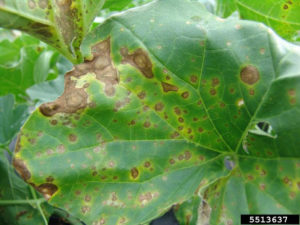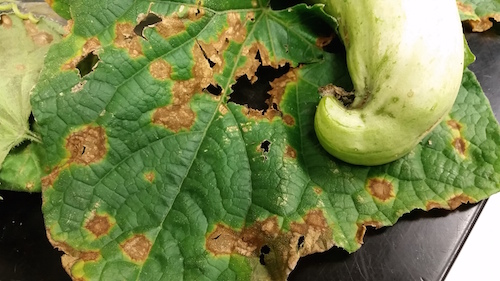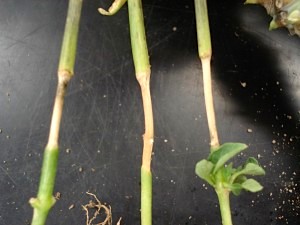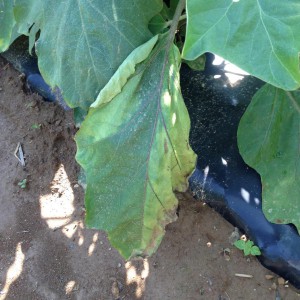Anthracnose and Alternaria leaf blight can become problematic in cucurbit crops during long periods of wet, humid weather. Both can cause significant losses if not controlled properly. With the production season quickly approaching, now is a good time to review a few of these important diseases.

Alternaria leaf blight on cantaloupe (NCSU – G. Holmes)
Anthracnose, caused by Collectotrichum orbiculare, and Alternaria leaf blight (Alternaria cucumerina) produce distinct spots on infected leaves, and in most cases, symptoms begin on the older leaves. With Alternaria, diagnostic concentric black rings will be develop within the spots on infected leaves, often there is a chlorotic (yellow) halo around margins. With Anthracnose, spots always develop on veins on the underside of infected leaves. Often, black setae (hair-like projections) will develop on the veins of infected tissue. These symptoms make for easily diagnosing which disease might be present.
Both pathogens can overwinter on infected plant tissue in the soil for 1 to 2 years, thus extended crop rotations are important. Conidia (spores) develop from dormant mycelium in the soil and are splashed into the canopy causing primary infections during prolonged periods of humid, wet weather causing extended leaf wetness. Secondary infections and spread of both diseases can occur during the production season under favorable conditions for disease development.
Deep plowing debris or the removing of plant debris after harvesting, avoiding overhead irrigation during the production season, and most importantly, choosing cucurbit varieties with resistance are important cultural practices all conventional and organic growers should consider.
Anthracnose and Alternaria are easily controlled with weekly protectant fungicides such as chlorothalonil and mancozeb as long as they are applied prior to the arrival of the pathogen and on a regular basis during favorable disease development. Organic growers can apply copper and other labeled products to help suppress development of these diseases. Complete foliar coverage is critically important for the control of these diseases.
For more information on the control of anthracnose and Alternaria leaf blight in cucurbit crops please see the 2020/2021 Mid-Atlantic Commercial Vegetable Production Recommendations Guide.
Additional Resources:
University of MN Extension: https://extension.umn.edu/diseases/alternaria-leaf-blight
University of Florida: https://plantpath.ifas.ufl.edu/u-scout/cucurbit/alternaria-leaf-spot.html – Images of Alternaria
University of Florida: https://www.growingproduce.com/vegetables/aim-to-keep-anthracnose-out-of-your-cucurbit-crops/ – Additional information on anthracnose
University of MN: https://extension.umn.edu/diseases/anthracnose-cucurbits – Additional information on anthracnose of cucurbits



